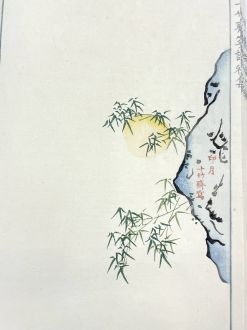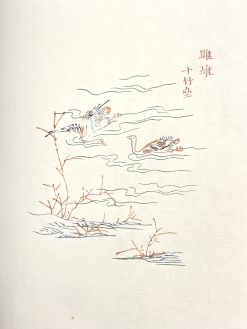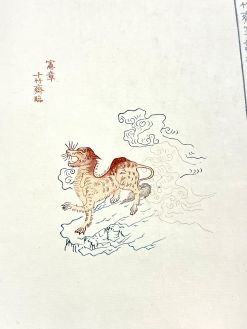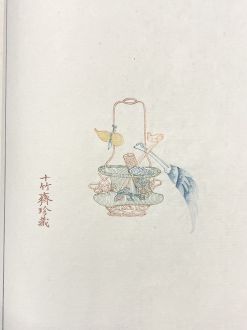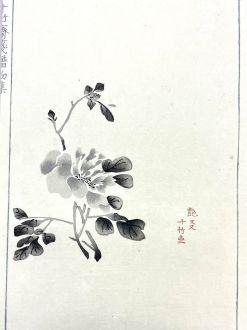Chinese Poetry Paper by the Master of the Ten Bamboo Hall
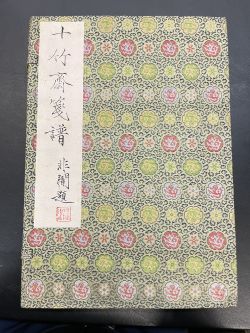
Introduction
Chinese Poetry Paper by the Master of the Ten Bamboo Hall("Ten Bamboo Hall Poetry Paper") is a collection of paintings first published by Zhengyan Hu in 1644 in China. In 1952, using the same printing technique as in the first publication, Beijing Rongbao reprinted the book and issued a limited reprint edition of 300 copies. The book has 4 volumes with 16 chapters, each focusing on one category such as birds, insects, animals, flowers, utensils, plants, stones, mountains, people, scenery, etc. The substrate is Chinese Xuan paper, a kind of thin paper fits perfectly with Chinese painting and calligraphy. The book is thread-bound as many old Chinese books are. It is not only the ancient poetry paper book with the largest number of patterns and designs, but also a treasure work combining painting, engraving and printing techniques of the Ming dynasty.
-
moon
-
fish hawk
-
son of the dragon
-
basket
-
flower
Woodblock Water Printing
The special printing technique adopted by this book is called the woodblock water printing. The book marked the pinnacle of this special technique which represented the highest level of color overprinting technology in ancient times. Color printing in China began during the Song and Yuan dynasties. Color overprinting reached a flourishing period during the Wanli period of the Ming Dynasty, with the emergence color printing pictures. To the end of the Ming Dynasty, the woodblock water printing emerged. It is based on color overprinting and developed from the special multi-color overprinting method in Huizhou city during the Wanli period. The objects in the printed works have the shades of color and ink, and the printed paintings are almost identical to the originals. "Gong Hua" is a special part of woodblock water printing, a kind of engraved printing method without inking. Similar to the modern printing technology of embossing, the two carved concave and convex plates are nested together and arched on the Xuan paper, so that the page can be engraved with various types of light-colored or white ornaments. It uses the protruding lines of the ornaments to show the charm of the painted flowers, birds, fish, insects, artifacts and treasures. [1] "Gong Hua" is also observed in many patterns in this book.

The "Ten Bamboo Hall" which appeared in the name of this book is where the woodblock water printing technique was invented and developed. In 1952, when Beijing Rongbao reprinted the book, it invited the skilled craftsmen from Nanjing Ten Bamboo Hall as the technical force. In order to revive the ancient skills, Ten Bamboo Hall later sent craftsmen to Beijing Rongbao to learn woodblock water printing from a few masters in 1988 and 1989.[1]
Now, the woodblock water printing technique has been certified as an Intangible Cultural Heritage.
History
The reprint version that came out in 1952 should be attributed to two male activists and writers at that time: Xun Lu and Zhenduo Zheng. Lu once commented that the "Ten Bamboo Hall Poetry Paper" is "the highest achievement of the plaything for the literatisince the Ming and Qing dynasties." In 1934, he wrote a letter to Zheng, saying that the "Ten Bamboo Hall Poetry Paper" samples of flowers are the most exquisite, and this artistic approach exceeds many modern masterpieces; the landscapes inside are also very well engraved. " Then in April of the following year, Lu said to Zheng: "Such good set of books in the Qing Dynasty has been rare. Even in the future, I am afraid that there may not be such engraving and printing skills. Maybe in the next three hundred years, there will be no better than it." Zheng proposed to reprint the "Ten Bamboo Hall Poetry Paper" and asked for Lu's opinion. Lu also expressed a great interest in this project, and the motion was finally implemented. However, reprinting the book was very difficult, as the original copy published in 1644 was hard to find for Zheng.Eventually, Zheng borrowed a copy from Xiaoci Wang in Beiping and asked Rongbao to try out the reprint. He sent two samples of the reprint work to Lu. These two celebrities, one in Shanghai, one in Beiping, frequently disscussed the paper and pigments, layout, pricing, publication time and other issues via letters. Lu also wrote the reprinting description for the book, printed on the flyleaf of the book.
Poetry Paper
Cultural Implications
Impact and Significance
Though this book was famous in China, it also has a great influence in Japan, and after woodblock water printing was spread to Japan from China, Japanese did a great job in promoting this technique and adapting it to their own works of culture. This book is also regarded as a treasure by the Japanese. The 1952 version book at Kislak center is an example: it was donated by a collector that exclusively collects Japanese items. In recent years, there were also many exhibitions about the book, aiming to facilitate the communication on this book between China and Japan. Starting from the 1940s, this book was translated, printed and published in many Western countries such as the US, Switzerland, and Germany.
